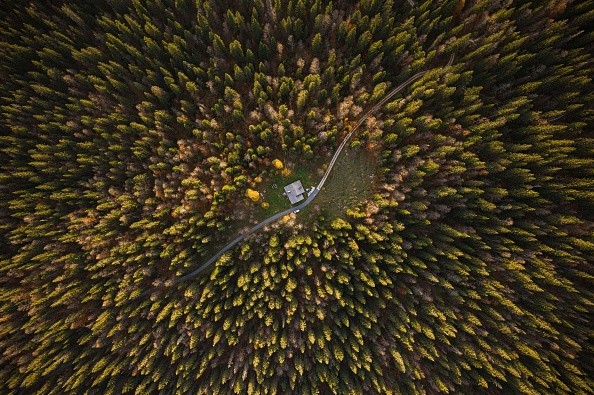Researchers created maps that show where warmer weather has left trees in unsuitable conditions, making them more vulnerable to extinction by other species.
Long-term wildfire and ecosystem management in these 'zombie forests' could benefit from the findings.
The warming in California's Sierra Nevada conifer forests
 (Photo : VALENTIN FLAURAUD/AFP via Getty Images)
(Photo : VALENTIN FLAURAUD/AFP via Getty Images)

The conifer tree native to the lower elevations of California's Sierra Nevada mountain range has found itself in an unrecognizable climate, much like an old man suddenly realizing the world has moved on without him, as per ScienceDaily.
According to a new Stanford-led study, roughly one-fifth of all Sierra Nevada conifer forests - symbols of Western wilderness - are a "mismatch" for their regions' warming weather.
The paper, which will be published on February 28 in PNAS Nexus, describes how such "zombie forests" are likely to be replaced by tree species better adapted to the climate after one of California's increasingly frequent catastrophic wildfires.
According to study lead author Avery Hill, who was a graduate student in biology at Stanford's School of Humanities & Sciences at the time of the research, forest, and fire managers need to know where their limited resources can have the greatest impact.
This research lays a solid foundation for understanding where forest transitions are likely to occur and how they will affect future ecosystem processes such as wildfire regimes.
Hill led a related study last November that demonstrated how wildfires have accelerated the range shift of Western trees.
Sierra Nevada conifers such as ponderosa pine, sugar pine, and Douglas fir are among the tallest and largest living things on the planet.
Since the 1930s, temperatures have risen by an average of a little more than 1 degree Celsius, or 2 degrees Fahrenheit.
Meanwhile, spectacular scenery, relaxed lifestyles, and relative affordability have drawn a massive wave of new human residents to the lower elevations of the Sierra Nevada in recent years.
Hotter weather increased construction, and a history of fire suppression has fueled increasingly destructive wildfires, making the names of towns like Paradise and Caldor synonymous with Mother Nature's wrath.
Hill and his colleagues began by combing through vegetation data dating back 90 years when the vast majority of human-caused warming had not yet occurred.
With this data, the researchers' computer model revealed that the average elevation of conifers has shifted 34 meters or nearly 112 feet upslope since the 1930s, while the temperatures most suitable for conifers have outclimbed the trees, shifting 182 meters or nearly 600 feet upslope on average.
In other words, the rate of change has outpaced many conifers' ability to adapt or shift their range, leaving them vulnerable to a replacement, particularly after stand-clearing wildfires.
According to the study, approximately 20% of all Sierra Nevada conifers are mismatched with the climate around them.
The majority of those mismatched trees can be found below an elevation of 2,356 meters (7,730 feet).
Even if global heat-trapping pollution falls to the low end of scientific projections, the number of Sierra Nevada conifers that are no longer suited to the climate will more than double in the next 77 years.
Also Read: Genome of Conifers Remains Stable Over Last 100 Million Years
Losing America's Western conifer forests to climate change
Conifers, such as Douglas fir (Pseudotsuga menziesii) and ponderosa pine (Pinus ponderosa), are particularly fire-resistant, as per Yale.
However, as the West's climate warms and dries, there is a shift in fire behavior that could permanently alter the composition of these iconic forests.
The Klamath Mountains, which encompass the southernmost extent of the Cascade Mountains in Northern California and Southern Oregon, are particularly prone to fire.
A large fire, with its destructive power, can provide an advantage to plants that would otherwise be outcompeted.
Life quickly returns to post-fire landscapes, grappling and fighting for the newly discovered space in which to grow.
Shrubby plants such as chinkapin, tanoak, madrone, and canyon live oak are usually the first to populate these post-fire areas.
Soon after, new conifers emerge and, given the right conditions, shoulder their way past their competitors, eventually overtopping and shading out the sun-thirsty scrubland, establishing a new conifer forest.
Conifers require specific conditions in order to recover from a fire.
Because of their steep terrain, the Klamath Mountains experience a variety of wet and dry conditions, with the driest being used to forecast normal future conditions.
These conditions, combined with the Klamaths' frequent wildfires, make the Klamaths an ideal location for studying a forest's response to fire.
Related article: About 21,000 Species Face Extinction, IUCN Updates Red List
© 2024 NatureWorldNews.com All rights reserved. Do not reproduce without permission.


![Climate Change is Reducing Dust Levels Worldwide as Arctic Temperature Warms [Study]](https://1471793142.rsc.cdn77.org/data/thumbs/full/70320/280/157/50/40/climate-change-is-reducing-dust-levels-worldwide-as-arctic-temperature-warms-study.jpg)


